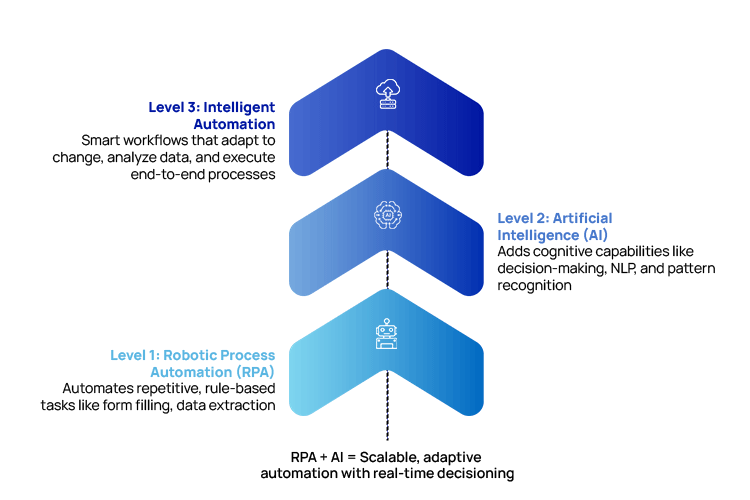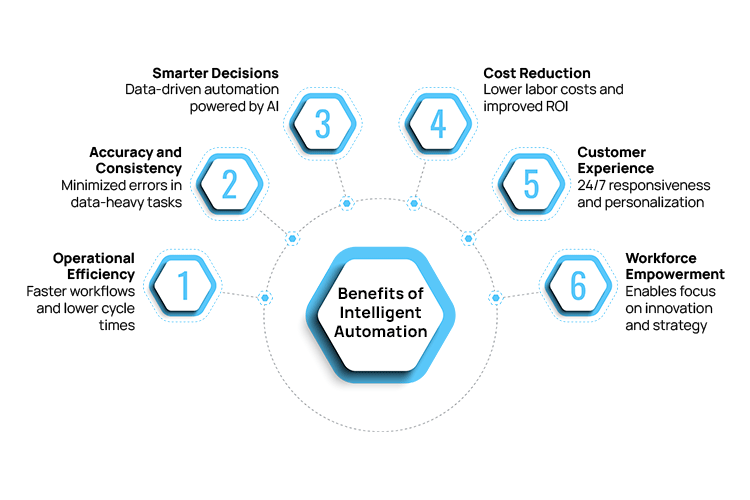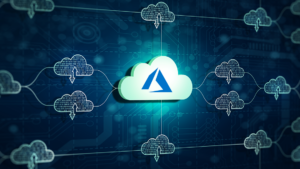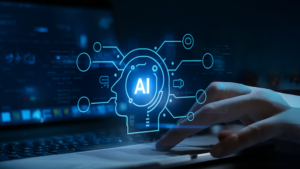

ACL Digital
5 Minutes read
Combining AI + RPA: The Future of Intelligent Workflow Automation
Technological advancement continues to redefine how businesses operate, compete, and grow. Among the most impactful developments in this space is the convergence of Artificial Intelligence (AI) and Robotic Process Automation (RPA). This integration is driving the next wave of innovation in enterprise automation, commonly referred to as Intelligent Automation.
AI equips systems with the ability to learn, reason, and make informed decisions based on vast amounts of data. RPA, on the other hand, specializes in executing structured, rule-based tasks with consistency and precision. When combined, these technologies enable organizations to move beyond routine automation and build intelligent workflows that adapt to context, anticipate needs, and deliver measurable business value.
In this blog, we delve into how the strategic integration of Artificial Intelligence (AI) and Robotic Process Automation (RPA) is transforming business operations. By combining AI’s cognitive capabilities with RPA’s execution power, organizations can streamline processes, reduce costs, and unlock greater agility. Learn how Intelligent Automation enhances efficiency, decision-making, and customer experience, and how your organization can leverage it to stay competitive in a digital-first economy.
What is Artificial Intelligence?
Artificial Intelligence (AI) enables machines to mimic human intelligence by learning from data, understanding language, interpreting visuals, and making informed decisions.
What is Robotic Process Automation (RPA)?
Robotic Process Automation (RPA) automates repetitive, rule-based tasks by mimicking human interactions with software to improve accuracy and efficiency.
What is Intelligent Workflow Automation?
Intelligent Workflow Automation combines Artificial Intelligence (AI) and Robotic Process Automation (RPA) to automate both simple and complex business processes. It enables systems to make decisions, adapt to changes, and execute tasks with minimal human involvement.
Why Combine RPA and Artificial Intelligence?
RPA is highly effective at executing structured, rule-based tasks with speed, precision, and consistency. Think of it as a tireless digital assistant that follows clearly defined instructions to streamline repetitive processes like data entry, form filling, and report generation. However, when processes involve unpredictability, exceptions, or the need for contextual understanding, RPA alone reaches its limits.
This is where AI adds critical value. AI brings cognitive capabilities such as pattern recognition, natural language processing, and decision-making that enable systems to adapt, learn from data, and handle unstructured inputs or dynamic scenarios. By combining AI with RPA, organizations can build Intelligent Automation systems that go beyond task execution and deliver real-time intelligence and adaptability.
Together, AI and RPA form a powerful synergy. RPA manages data collection and execution at scale, while AI interprets that data, makes decisions, and guides bots through complex workflows. This collaborative approach enhances automation capabilities and helps organizations unlock strategic benefits across their operations.
Comparison Table: RPA vs AI vs Intelligent Automation
| Feature/Aspect | Robotic Process Automation (RPA) | Artificial Intelligence (AI) | Intelligent Automation (IA) |
| Primary Function | Automates rule-based, repetitive tasks | Mimics human intelligence and decision-making | Combines RPA and AI to automate end-to-end workflows |
| Data Type Handled | Structured | Unstructured and structured | Both structured and unstructured |
| Learning Capability | No (rule-based only) | Yes (via ML, NLP, etc.) | Yes (via embedded AI components) |
| Adaptability | Low – follows pre-defined rules | High – can adapt and learn | High – adapts based on real-time context |
| Human Involvement | Low after setup | Moderate – for model training and feedback | Minimal – for oversight and optimization |
| Use Case Examples | Invoice processing, data entry | Chatbots, fraud detection, image recognition | Customer service automation, claims processing |
| Output | Task execution | Insights, predictions | Autonomous decision-making and execution |
| Best Fit For | Simple, repetitive workflows | Complex, cognitive tasks | Complex, multi-step, decision-driven processes |

The Business Impact of Combining AI + RPA: Six Key Advantages
- Operational Efficiency
Combining AI with RPA streamlines complex workflows, reduces manual intervention, and accelerates task execution. This results in faster turnaround times and improved overall productivity. - Accuracy and Consistency
AI enhances RPA by reducing human error, ensuring data accuracy, and maintaining consistent outcomes across high-volume, rule-based, and decision-oriented processes. - Intelligent Decision-Making
AI analyzes large datasets to uncover trends and insights, enabling RPA bots to make smarter, context-aware decisions in real-time. - Cost Reduction
Intelligent Automation minimizes labor-intensive tasks, reduces overhead, and enables resource optimization. This helps businesses lower operational costs and increase return on investment. - Enhanced Customer Experience
AI and RPA enable faster response times, round-the-clock support, and personalized interactions. These capabilities significantly improve service quality and customer satisfaction. - Workforce Empowerment
By offloading repetitive tasks to automation, employees can focus on innovation, strategy, and customer engagement. This leads to a more agile and motivated workforce.

Challenges and Limitations of AI + RPA
- Complexity of Integration
Integrating AI with RPA requires aligning diverse systems, workflows, and data models to ensure seamless integration. Without proper planning, deployment can become resource-intensive and technically complex. - Data Quality Issues
AI systems rely heavily on accurate, clean data. Poor data quality can compromise decision-making, resulting in inefficiencies or incorrect automation outcomes. - Change Management
Adopting AI and RPA demands a cultural and operational shift. Resistance from teams and lack of training can hinder successful implementation. - Security Concerns
Automation increases access to sensitive data and systems. Without robust governance, organizations may face compliance risks and potential cyber threats. - Initial Investment
Deploying AI and RPA tools often involves significant upfront costs. These include software, infrastructure, and skilled resources needed to implement and scale. - Maintenance and Monitoring
Automated systems require ongoing oversight to ensure performance, accuracy, and relevance. Continuous updates, error handling, and model retraining are essential.
How to Integrate RPA and Intelligent Automation?
To effectively integrate RPA and Intelligent Automation into business operations, follow these key steps:
- Assess Workflow Suitability: Identify rule-based, high-volume, and time-intensive processes that are ideal for automation.
- Choose the Right Approach: Determine whether to use RPA, Intelligent Automation, or a hybrid approach, based on the workflow complexity.
- Select Suitable Tools: Opt for automation platforms that align with your existing infrastructure and long-term goals.
- Map the End-to-End Workflow: Clearly define all steps, bottlenecks, and decision points within the workflow to ensure a comprehensive understanding.
- Deploy RPA for Rule-Based Tasks: Use RPA to automate repetitive, structured tasks for improved efficiency.
- Incorporate AI/ML: Enhance automation by integrating AI and machine learning to handle unstructured data and complex decision-making.
- Test and Optimize: Continuously monitor, test, and refine automation processes to ensure ongoing effectiveness and performance.
Conclusion
The convergence of AI and RPA is no longer a forward-looking concept. It is a present-day imperative for businesses striving to stay competitive in a digital-first world. By combining the precision and scalability of RPA with the cognitive capabilities of AI, organizations can unlock intelligent workflows that are faster, smarter, and more adaptable than ever before.
While challenges such as integration complexity and data quality must be addressed strategically, the long-term gains in operational efficiency, decision-making, customer satisfaction, and workforce empowerment make the investment worthwhile.
As businesses continue to evolve, those who embrace Intelligent Automation today will be the ones leading tomorrow’s innovation.
Looking to future-proof your workflows with intelligent automation?
Start your intelligent automation journey with ACL Digital’s next-gen solutions. Explore our digital transformation services or speak to our automation experts to discover what’s possible.
Sources
- https://www.itconvergence.com/blog/from-automation-to-innovation-how-do-ai-and-rpa-work-together/
- https://www.xponential.digital/blog/the-future-of-automation-combining-ai-and-rpa-for-business-success/
- https://techvaria.com/The-Future-of-Automation-Combining-AI-and-RPA-for-Business-Success.html
- https://www.blueprism.com/resources/blog/rpa-and-ai/ https://www.ibm.com/topics/intelligent-automation
- https://www.mckinsey.com/capabilities/mckinsey-digital/our-insights/the-next-horizon-for-industrial-manufacturing
- https://mapsted.com/blog/how-intelligent-workflow-automation-is-transforming-businesses?utm
- https://www.rayven.io/blog/intelligent-workflow-automation?utm
Related Insights


Death to Prompting! Long Live Programming!

The AI Developer’s Guide to Data Formats: TOON vs. JSON and Beyond


Matter Protocol: Powering the Smart Infrastructure of Future Cities

